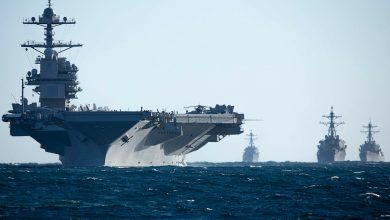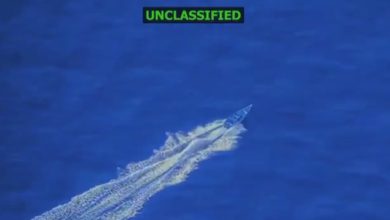Europe’s long-range strike project nears choice of lead contractors

PARIS — The six European countries cooperating on a conventional long-range, ground-launched strike capability may announce the lead companies for the project in June, according to one of the co-authors on a French parliamentary report on the state of artillery.
The European Long-range Strike Approach (ELSA) coalition has identified 13 development pillars, and in June is expected to define who is responsible for what, said Jean-Louis Thiériot, a French deputy who sits on the National Assembly’s defense committee, in a hearing here last week.
The lead on each segment will be determined based on a “best athlete” approach, Thiériot said. France will play a “major role” through rocket builder Ariane Group for the ballistics segment, according to the lawmaker, who struck an optimistic tone about progress on ELSA.
“What is very interesting about this project is that it is indeed a coalition of volunteers and sovereign states, and it has been achieved without getting bogged down in the bureaucratic red tape that can often be encountered in more bureaucratic forms of cooperation,” Thiériot said.
“We are really at the beginning, but something is working,” he added.
France, Germany, Poland and Italy signed a letter of intent on the long-range strike initiative at a NATO summit in Washington in July 2024, with Sweden and the U.K. joining in October.
European NATO members have a capability gap in long-ranged strike compared with Russia, which operates several ground-launched ballistic and cruise missiles with ranges of between 500 kilometers and 2,500 kilometers, and capable of hitting targets across Europe, according to the International Institute for Strategic Studies
France’s current lack of a land-based, deep-strike capability creates a risk of nuclear deterrence being circumvented, with a gap between the lower threshold of nuclear deterrence and the maximum of what the conventional forces can do, according to the parliamentary report. ELSA could address that gap, with a capability separate from France’s plans to replace its rocket artillery.
Thiériot said there is political will to move forward on ELSA, combined with “manufacturers who will not get involved in cumbersome mechanisms such as the European Defence Fund, where you have to find the necessary number of partners, which means that you end up taking the SME that makes bolts to make ailerons.”
“There is a real desire for efficiency,” the deputy said. “It’s something that can work, both in the French interest and in the European interest, so it really seems like a good model to me. We’ll talk about it again in a year.”
Ariane Group, MBDA, Safran and Thales all either didn‘t immediately respond to requests for comment, or had no immediate comment. MBDA has proposed its Land Cruise Missile, a land-based version of the company’s Missile de Croisière Naval, as a short-term solution for ELSA.
Ballistic and cruise-missile technologies each have comparative advantages, and ideally both technologies would be developed for strike capability in the range of 1,500 to 2,000 kilometers, the report said. Ballistic tech primarily focuses on fixed targets, while cruise missiles allow for precision strikes on fixed or mobile targets.
The ground-based, long-range strike capability would be a useful complement to existing air and sea-launched cruise missiles, according to the report. Diversifying delivery systems would significantly increase options available to political decision makers and provide an additional offensive vector for possible escalation management.
“The commitment of all joint strike assets at great depth would make it possible to combine trajectories and saturate the enemy’s defenses at specific points, forcing them into dilemmas,” the French artillery report said.
The deep strike capabilities of the French Navy and Air Force face constraints due to air defenses and access denial. A land-based system could offer greater flexibility, including for opportunistic targeting, according to the report.
Feedback from hearings and visits to Ukraine suggests interception of ground-based ballistic missiles by air defenses remains very low, “significantly lower” than for cruise missiles, according to Thiériot. If one technology were to be chosen due to budgetary constraints, developing ground-based ballistic technology for land-based long-range strike is more important, the report stated.
“I would add that the ideal solution would be to do both,” Thiériot said.
France’s work on nuclear deterrence and ballistic strike capability means it has companies such as Ariane Group able to “quickly master these capabilities,” Thiériot said.
Meanwhile, French defense manufacturer Turgis Gaillard on Wednesday announced a truck-mounted long-range strike system dubbed Foudre, able to fire both French and allied munitions, with the company saying it will present the system at the Paris Air Show in June.
France’s Directorate General for Armament is already working with a consortium of Safran and MBDA and another of Ariane Group and Thales to develop a tactical strike capability in the 150-kilometer range to replace the French Army’s remaining fleet of decades-old rocket launchers.
Turgis Gaillard has presented its system as complementary to what is being developed with the DGA, as the launcher would be able to fire the munitions developed by the two consortiums, according to Matthieu Bloch, a member of parliament and co-author of the artillery report.
Bloch said fire control and missiles for the launcher are critical and require a sovereign solution, whereas chassis and launch pods are non-critical elements.
Rudy Ruitenberg is a Europe correspondent for Defense News. He started his career at Bloomberg News and has experience reporting on technology, commodity markets and politics.







